This story from the Australian Aviation archives comes from May 2014, when Gerard Frawley spoke to then Jetstar group chief executive Jayne Hrdlicka as the Qantas-owned low-cost carrier (LCC) celebrated 10 years since its first flight.
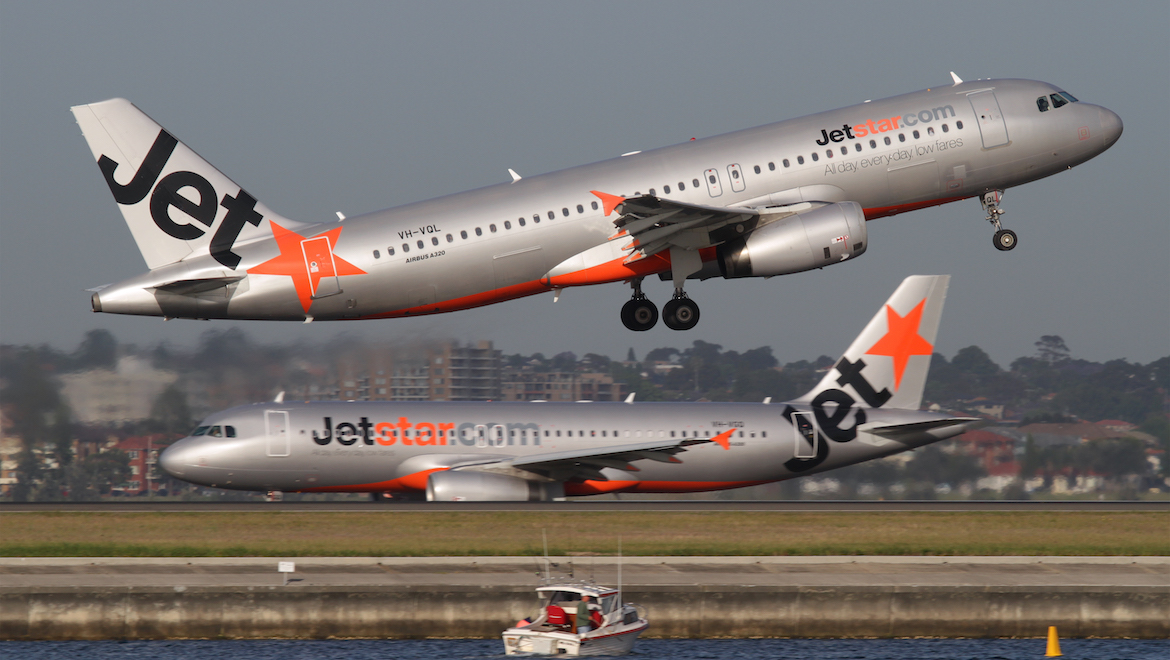
During a 50-minute interview, one word stands out more than any other – “opportunity”. Jetstar may have posted its first loss since its start-up phase, but CEO Jayne Hrdlicka is upbeat about the prospects for the Qantas Group’s low-cost carrier (LCC) subsidiary, and the many opportunities before it.
May 25 marks the 10th anniversary of Jetstar’s first revenue flight. In the decade since it has grown remarkably, from an initial fleet of 14 Boeing 717s serving 14 Australian domestic destinations, to today where Jetstar is in fact a group of seven airlines operating almost 120 aircraft to 64 destinations in 16 countries.
Not bad for an airline that grew out of the operations of the former Impulse Airlines, which then Qantas CEO Geoff Dixon famously acquired in 2001 for “a rainy day”. That rainy day has turned into a deluge of orange-starred Airbus A320s (plus a smaller number of A321s, A330s and 787s) plying a network of 130 routes stretching across Australia, New Zealand, South-East Asia and Japan.
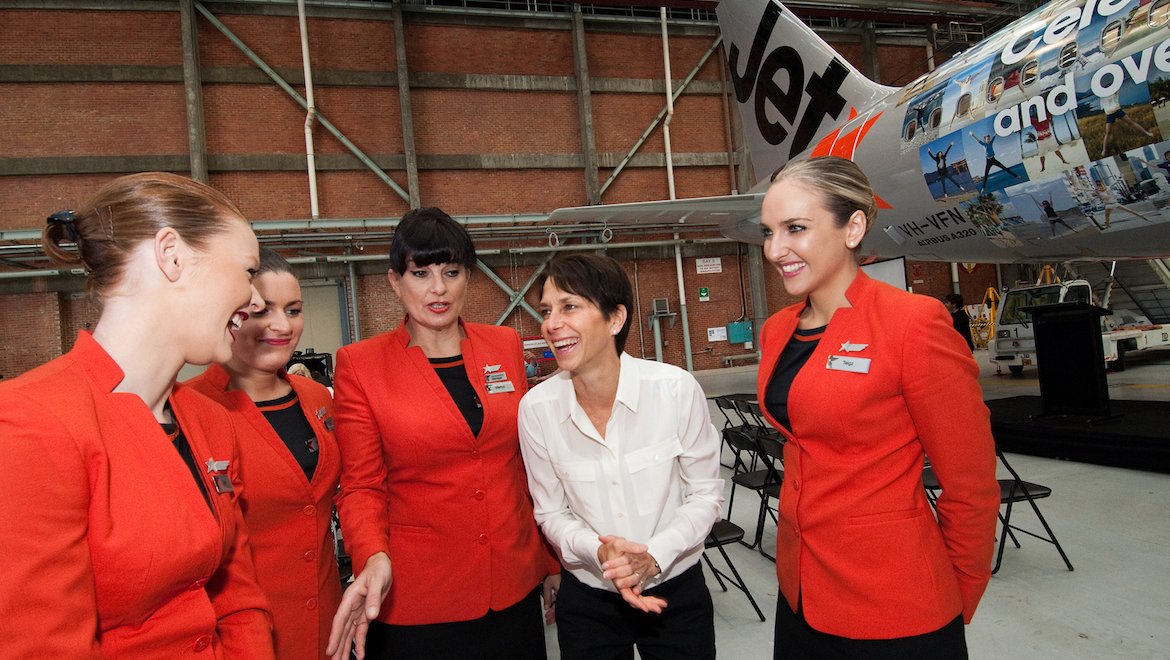
“I don’t think anybody in the first year of Jetstar’s establishment would have imagined what we’d look like today,” reflects Hrdlicka, Group CEO of Jetstar since mid 2012.
“In that timeframe we’ve done a few things pretty remarkably. One is to pioneer the development of the LCC market in Australia, but to do that in a way that was very evolutionary. We started off with a very pure LCC model, really using Ryanair as the template, and pretty quickly realised that wasn’t so relevant for this market, and it needed to be evolved, protecting the low-cost position, but being very mindful of the consumer environment we were in, and building a business that consumers would love and grow to depend on for travel that they needed low fares for. So I think we’ve been hugely successful at doing that, and in the process of figuring out how to listen, learn and grow a business, mindful of the environment that we’re in. That’s created opportunities for New Zealand, Singapore, Vietnam, Japan, and soon to be Hong Kong, with the government’s blessing.”
Nonetheless, the 10th anniversary comes at a challenging time for Jetstar. For the six months to December 31 last year Jetstar posted a loss of $16 million, its first since its start-up phase a decade ago, but a result that continued the downward slide that saw a 32 per cent drop in full year fiscal 2013 profits, albeit to a still-healthy EBIT profit of $138 million.
Explains Hrdlicka, “the simple facts are you’ve got an Australian market that’s overheated, and while we’re still profitable domestically in Australia, the margins are very thin, and we’re quite fortunate to have the lowest cost base of any carrier in Australia, so we can weather it better than most, but it still squeezes margins and it’s taken a massive toll on the Jetstar profit book.
“Our business in New Zealand’s doing well and improving. The Singapore market’s also overcooked with too much capacity, so South-East Asia’s a big challenge from that standpoint. Vietnam, it’s a strong business, it’s doing much better than it’s ever done before. Hong Kong’s a tiny piece of the puzzle, and Japan’s a business that’s got huge potential, and that’s tracking slightly ahead of the business plan.
“So what’s different? The things that were different really were too much capacity in Singapore and too much capacity in Australia, that’s really what drove the different performance relative to history.”
VIDEO: Jetstar’s 10-year anniversary celebrations included a family day in Melbourne, as shown in this 2014 video from the airline’s YouTube channel.
Rising fuel costs and foreign exchange movements were also big factors behind the loss, the Jetstar Group CEO explains, but, despite the excess capacity in the market, Australian “domestic remains profitable”.
Further, Hrdlicka downplays the financial impact the nascent Jetstar Hong Kong operation is having on Jetstar’s bottom line, even if it is still awaiting regulatory approval to begin flying and seven brand-new A320s allocated to it are sitting idle at Airbus’s Toulouse factory.
“The misunderstandings around Hong Kong are significant, and it’s really I think a misunderstanding about the Jetstar model generally speaking. We’re a minority investor in our businesses in Asia. Those businesses have business plans, they have other shareholders, they have boards. The business plans call for a certain level of aircraft at various stages, they show the cash flow requirements, and therefore here’s how much capital those businesses need. We pay in our fair share, and then the business manages its cash. It doesn’t call for any more cash from us as a consequence of a slowdown in start-up or anything else. In fact, our losses are less because we’re not flying.”
Continues Hrdlicka: “So it’s a funny thing, and quite frustrating to the team in Jetstar, because Asia’s not part of the problem. Asia’s part of the future.”
Still, that near-term future is seeing Jetstar halt growth for its Singapore-based Jetstar Asia operation due to “overheated” market conditions.
“And that happens from time to time in aviation, this is a cyclical business, and unfortunately nobody has perfect visibility as to what the competitors are doing, and the airports and local market jurisdictions are sometimes motivated to drive growth that’s not reasonable because it’s good for the airports, and it’s good for moving people around who spend money when they arrive where they’re going. It’s not necessarily good for the airlines.
“And because no one airline can see what another airline’s doing, they think that their growth is perfectly reasonable in the context of what they see the market do, until they see how much other capacity’s arrived right next to the aircraft they’ve ordered.”
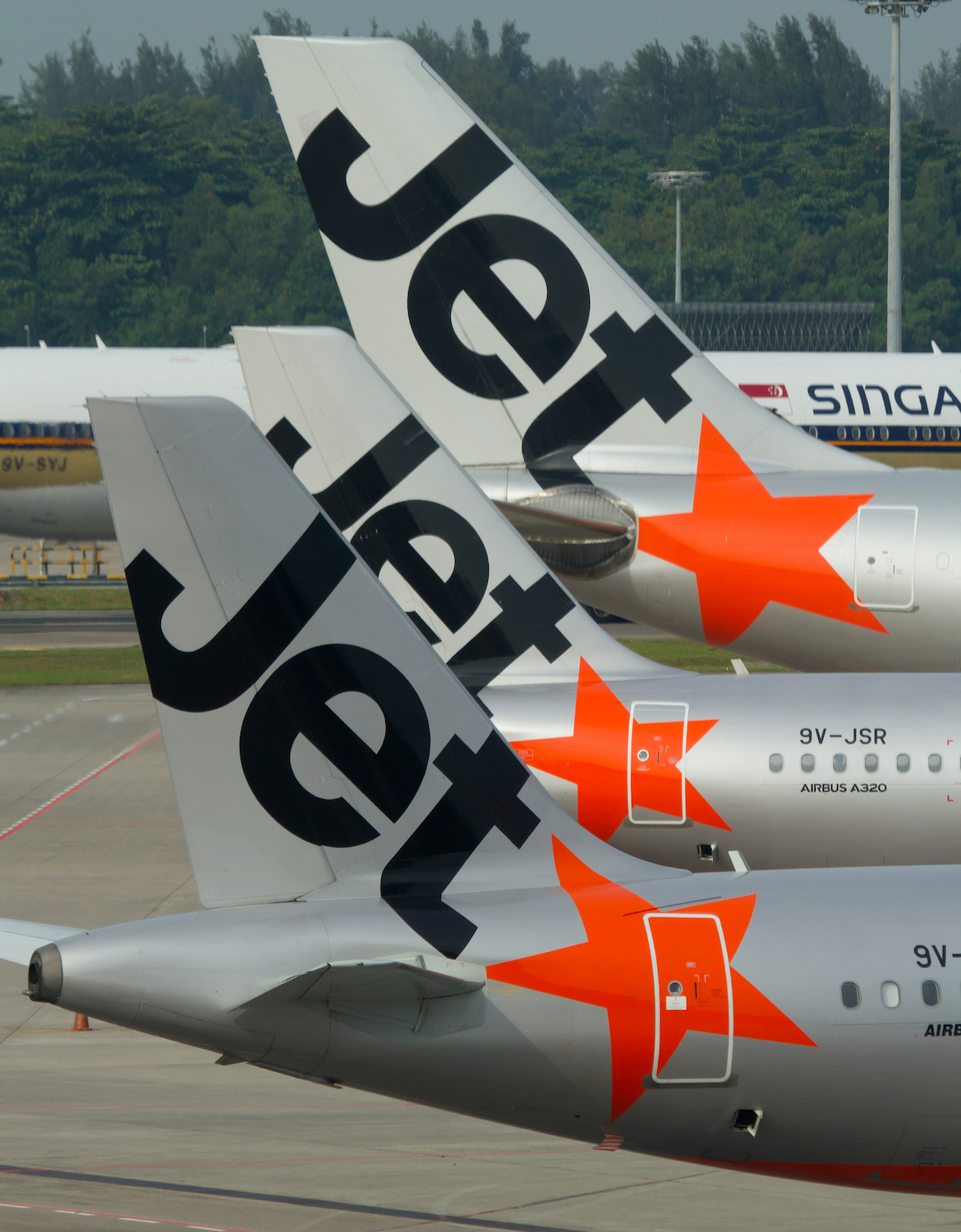
But there are signs of more rational behaviours returning.
“So at the end of the day the [explanation for the] first half performance for Jetstar is pretty simple, then the second half is of course going to continue to be challenging with the Australian market being overheated and South-East Asia still being overheated, although most of the major airlines that are playing in South-East Asia are pulling back on their fleet orders and changing their forecasts, which is great. So the signs are positive, but the reality of the changing supply/ demand dynamic is not yet being realised.”
Putting the brakes on Jetstar Asia is the most immediate response to that first half loss. While the Qantas Group is looking to shed 5,000 jobs, Jetstar’s contribution to that figure is negligible – “it’s a business as usual thing for us, and it’s tiny in the grand scheme of things. And it’s done.”
And while Jetstar will be making a contribution to the $2 billion in planned savings over three years, Hrdlicka explains that was occurring as business as usual at any rate.
“Every year we try to get a net two per cent reduction in cost, unit cost. So this is not a new thing for us. It is business as usual for Jetstar, in managing down its costs. And that contributes to the $2 billion Qantas Group target, but that is just what we do.”
Jetstar’s fleet order book also came in for attention as part of the Qantas Group’s cost-cutting measures.
Back in October 2011 Qantas announced a mega-order for 110 A320 series aircraft, then, and still, the biggest single commercial aircraft order in Australian history. At the time 11 were allocated to the ill-fated Qantas premium airline that was to be based in Asia.
Others were pencilled in for Jetstar’s expansion in Asia. But as part of the cost-cutting measures announced in February Qantas revealed the A320 order book would be “substantially restructured”, without providing further details at the time.
“What we’ve done is what any good business would do, and that is to ensure that we’ve got flexibility to bring aircraft in when we need to, and not before. So Airbus is working well with us as you’d expect from a partner standpoint, to ensure that we’ve got the ability to draw a fleet when we need them, and to aggressively grow the businesses where that’s appropriate. And where we’ve got overcooked markets, and we’ve got markets that are in overcapacity, we shouldn’t be growing aggressively.”
“We’ve just restructured the order so it better matches our expectations for growth in each one of the businesses, and each one of the airlines in Asia make their own decisions about how much aircraft they need and when they need them, and they’ve got the ability to buy aircraft out of the Jetstar/Qantas Group order stream or to go buy aircraft independently.”

Similarly, the last three of the 14 787-8s on order too have been deferred. The first 11 on order will allow for the one-for-one replacement of the existing long-haul A330-200 fleet, and indeed the 787’s increased seating capacity will bring the added capacity equivalent to an extra A330.
“We’ve not reduced the expected fleet size for the 787s, and we’ve not reduced the ASKs in that business, we won’t as long as it continues to be profitable and attractive flying,” says Hrdlicka. “And I mean really it’s a world of possibilities again, because the 787’s introducing different economics than we’ve seen before, and what that might bring once we get the fleet fully in place is not [fully] clear.”
The Jetstar boss describes the 787 as a “great” aircraft. “It’s performing well, it’s delivering the economic benefits we expected it to. I think we’re all getting positive surprises on the engineering side, we’re all getting positive surprises on the fuel efficiency front, customers love it, it’s a critical part of the portfolio for us, and really important when we’re competing against AirAsia X that we’ve got the ability to do that with a very competitive cost structure. And we fully expect that we’ll see more of AirAsia X, and we’re ready for that.”
VIDEO: The assembly of Jetstar’s first Boeing 787-8 as shown in this 2013 video from the airline’s YouTube channel.
More broadly it would be fair to say that Hrdlicka’s role is to make sure Jetstar is ready not just for the competitive environment it faces, but ready to exploit new opportunities as they present themselves.
“It’s a very important part of my role, to make sure that we’ve got the right strategy and the right growth agenda, and that we’re being very mindful of the trade-offs associated with the decisions that we take,” Hrdlicka explains.
“When we look at Asia, we don’t do anything other than look at where are the opportunities to build profitable, sustainable businesses that will be important parts of this network going forward, that will build from the experiences that we’ve had as a group to enable each of those businesses to find their own way and to develop their own opportunities off the back of all the history that we have as a business. And we continue to believe that’s a very signifi cant opportunity for growth for the Jetstar Group, but that will be on a very commercial, understood basis, we won’t be experimenting for the sake of experimenting, we will be as we have been making very concerted investment decisions where we think there are big opportunities, and we have strategic investors and shareholders who believe in that opportunity as well.”
Continues Hrdlicka: “Our model’s a very collaborative, inclusive model, where we have strategic shareholders, we play a role, a very well defined role in those businesses, but we don’t control those businesses, we don’t make the decisions for those businesses. Those businesses are run by local management, with local boards, and strategic investors who are long-term investors like we are, who see the opportunity to build something very special.”
Jetstar Japan could well prove one of those opportunities “to build something special”.
“I think the opportunity in Japan is very significant, and it would be a brave person to say today how big it could be, but I mean it’s the third, fourth biggest economy in the world, and we’re bringing low fares for the first time to the Japanese consumer. The Japanese consumer’s more optimistic than they’ve ever been before, and the world of possibilities is huge. There are certain routes we fly in Japan where every new schedule we introduce, every new flight we introduce, we have absolutely no difficulty filling it. And the performance of every route is well above our expectations for this point in its maturity, so all the underlying signals are very, very positive.”
So is Jetstar Japan the bright star in the Jetstar network?
“It really is, in terms of all the attributes for a very successful business over time, so we’re very positive about Japan.”
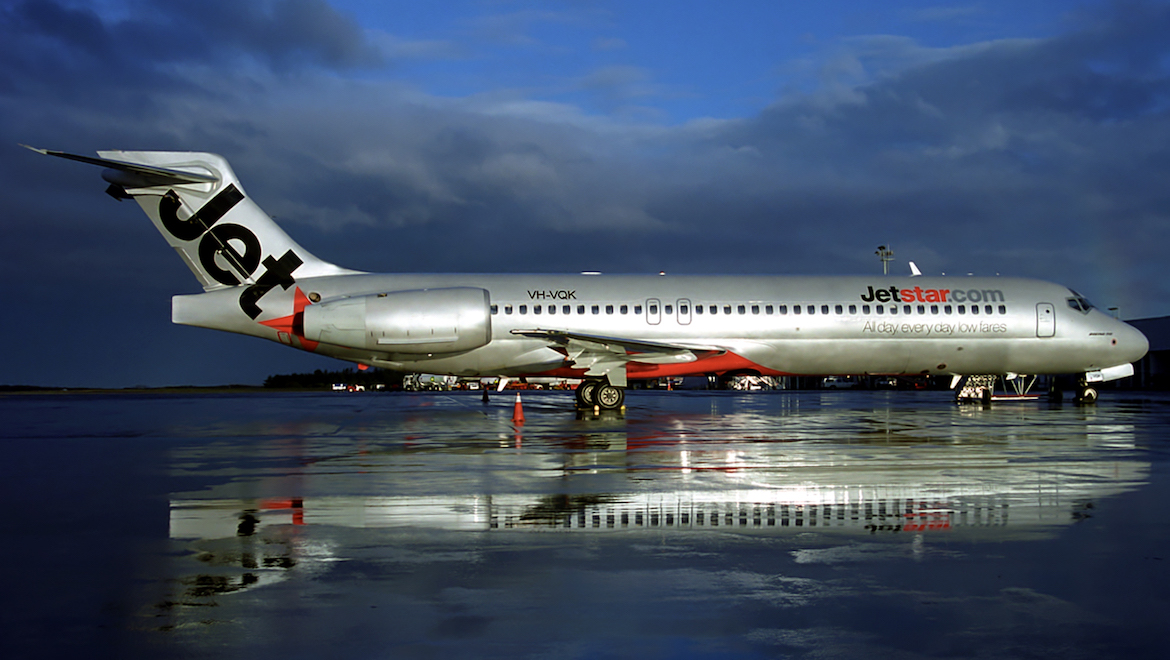
Certainly, after a decade of operating and experience in not just Australia and New Zealand but Singapore and Vietnam, Jetstar has plenty of experience and corporate knowledge it can bring to the table in helping Jetstar Japan entrench itself in the market, and getting Jetstar Hong Kong into the air.
“I think we’ve learned a lot in the process of building a great low fares business in Australia. We probably could have played a stronger role in education of the market in the early days, and so we’re taking a lot of those lessons learned as we build the business in Japan in particular, and in Vietnam, because both those businesses are businesses that have significant market development yet ahead of them.”
That learning is also proving a two-way street.
“I think a lot of the opportunity for ancillary growth and brand development for us in Australia will come from learning from our colleagues in Asia, because they’ve really taught us how to think outside the square, they’ve taught us to challenge convention, they’ve taught us to listen in a way that we otherwise might not have, and it’s invaluable. So the learnings are definitely both ways. We bring a lot of operational experience and market development experience out of Australia, and we’re learning how to build in different consumer environments and market differently, and market quickly and distribute differently by virtue of the portfolio experiences we’re having.
“Japan is an extraordinary example. The innovation we’re doing in Japan on distribution is I think the best practice in the world. We sell our low fares tickets in convenience stores in Japan, through a kiosk. And consumers love that, because it gives them confidence, they’re buying something new that they’re not used to buying, and they’re buying it in a trusted environment. So just the approach to customers, the way we’re using digital is different, the way we think about the website and the engagement strategies are very different market by market, and it’s just very dynamic.
“We’re a dynamic learning organisation, and we’re very proud to be an Australian business that’s very multicultural, multinational. Our centre of gravity will increasingly not be in Australia, and that’s exciting, because we’ll only be a better business in Australia as a consequence of that.”
That doesn’t mean Jetstar’s corporate offices will be moving north to Asia from its new premises in the inner Melbourne suburb of Collingwood.
“I don’t predict that as an eventual outcome because we have a lot of critical infrastructure here that other businesses draw on, and while there’s definitely a need to travel, that would be the case wherever you are.”
Instead, “there’s no one location where you’re in the centre of gravity. So it matters most where the depth of your intellectual property is and intellectual capability is as a business system.
“And we’re constantly changing as a business model, so we’ll continue to experiment with where the right location is for certain types of activity. Already today we have people who do web design and development in Singapore, and that’s been the case for a long time. And we do contact centre work … and we do … revenue accounting work in the Philippines. And we always think about where should we be doing things. But from a head office standpoint, we’re an Australian company. We’re multinational, but we’re an Australian company.”
The American-born Hrdlicka herself represents Jetstar’s multinational nature. Hrdlicka’s father defected to the US from communist Czechoslovakia during the Cold War in 1948, settling in a small town near Wichita, Kansas where Hrdlicka grew up.
After college Hrdlicka worked initially for what is now Ernst & Young, and then later Bain & Company (of Mitt Romney fame). By her late 20s she had left Bain to help with the turnaround of a company called Skybox, which specialised in collectibles such as baseball trading cards.
She was then headhunted to run a similar operation in Sydney in 1994, before returning to Bain & Company, but based in Australia where she would become a senior partner and where she led Bain’s Asia region customer strategy practice. It was here in the late 1990s that she worked on a consultancy project for a young Alan Joyce, who was then in charge of network planning at Ansett.
Fast forward to 2010 and Joyce approached Hrdlicka to join Qantas as group executive, strategy and technology, where she was responsible for the overall development of Qantas Group strategy. A little over 18 months after joining Qantas in August 2010 Hrdlicka was announced as Bruce Buchanan’s successor as Jetstar Group CEO, a role she officially assumed in July 2012.
“I think I’ve got one of the best jobs going. It’s a difficult challenge, but I can’t imagine a more interesting, exciting opportunity in business,” Hrdlicka says.
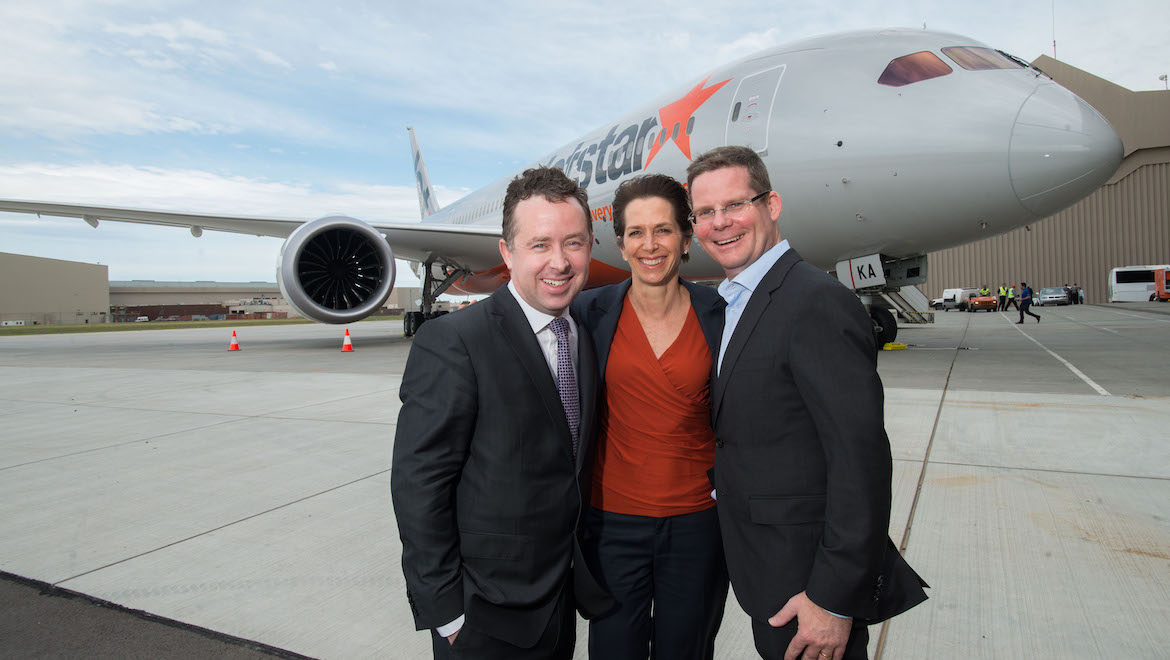
It has certainly been an eventful 20+ months running Jetstar.
“I think the approach that I took when I came into the business was to listen and learn and ask a lot of questions, to get a feel for the business. And I guess my observation early on was the customer and our people weren’t high enough in our priorities, and didn’t get as much focus as they needed to in order to build the kind of business that we could be. And so we’ve adjusted a little bit the settings on the strategy, and we’ve adjusted a little bit the settings on what we prioritise doing. And in the process we’ve found lots of additional opportunities to reduce cost, we’re delivering a much better experience for our customers, it gets better every day, and we’re creating better opportunities for our people and a better place to work, and creating an environment where people do really feel like we’re one team.”
Continues Hrdlicka: “We have a very distributed business where we don’t control all of it, but we’ve got huge opportunities to deliver on every day, and every single person in the company has a role to play. They have a role to play in making the environment a very safe place to work, and making sure that we are the safest of airlines in the region. They have a great role to play in driving our operational reliability. They’ve got a great role to play in managing our cost. Every single person touches the customer in one way, shape or form, and everybody’s got a role to play with the customer, and everybody’s got a role to play supporting each other and learning about the different challenges we have across the business and helping each other be the best that they can be.
“So I think we’ve come a long way. We’ve got huge opportunities still ahead of us. On the day I started, did I expect all the things that have unfolded over the course of the last 20 months or so? No. Is it better or worse? I think it’s mostly better, because it’s a richer, much more complicated business than I expected it to be from the standpoint of the structure and the relationships across different shareholders. That’s part of what makes us so strong, because we are really good at listening to what’s going on around us in the marketplace, we’re really good at responding, and quickly. We’re good at building great flexibility in the business model in terms of how we work to support all the different businesses based on what those businesses ask of us. And that just means we’re getting the best out of all of our partners and we’re getting the best out of the opportunities we have.”
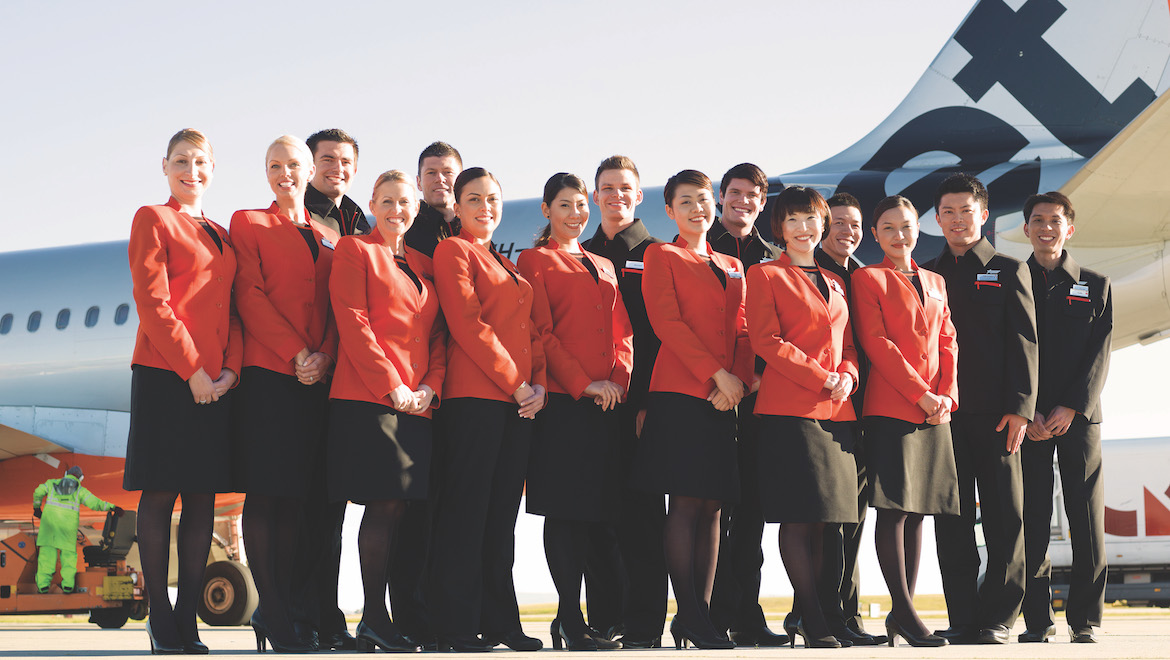
Asked about her priorities since taking the helm, Hrdlicka nominates a “greater orientation towards our people and everybody being accessible”.
“We’re a very flat structure, and everybody in my team and myself we’re out on the frontline of the business regularly. When we fly, we spend a lot of time with our pilots, we spend a lot of time with the cabin crew, we hang back, we thank our customers, and we work with the team to wrap up the aircraft for the next tour of duty. Everybody’s got skin in the game that relates to the frontline of the business, and that’s an important thing for all of us because that’s how you learn about where the opportunities are to improve the experience for our customer. That’s where you learn about the opportunities to make the experience as an employee of Jetstar a better experience.
“And so I guess the top of the list in terms of changes we’ve made are around the orientation towards people and customer, while also continuing to drive down our costs. And we’ve found more cost reduction opportunities by doing that than we otherwise would have.”
Hrdlicka explains that understanding the customer experience has been a key priority.
“We knew that the single biggest frustration was things not working well when things went wrong. So if there’s a cancellation, getting people re-accommodated on other flights and getting that done quickly and stress-free for our customers is a challenge. Reaching our contact centres was a big challenge. Talking to anybody at Jetstar about solving your problem was a challenge. And we’re not done with the fixes that we have, but all the research says we’re making huge progress.”
Hrdlicka points to the example of the Jetstar contact call centre in the Philippines.
“We collect NPS [net promoter] scores, which is a measure we use for customer advocacy, and at the start of the process we had quite negative NPS scores, it was difficult to reach them [the call centre], they weren’t motivated to solve problems, and it was generally a huge source of frustration for our customers. It cost us actually a lot of money as well, because customers kept ringing back. And the NPS scores are now actually quite good, because the contact centre is lined up to solve problems, they’re being well managed, and we are creating ways for customers to solve problems themselves as well as a solution to get things done when you need to get to somebody at Jetstar who can help you.”
Addressing customer problems more effectively is vital, Hrdlicka says.
“The funny thing is it takes a little bit more focus from a management standpoint, and less man-hours from a contact centre point of view, because you’re resolving issues the first time they get into the contact centre, you don’t bounce it for 10, 15 calls. Not that that happened very often, but when it did, that’s hugely frustrating to the customer and it actually cost us a lot of money. And the cheapest thing is to help a customer solve their problems quickly, and the customer’s happy and it costs you as little as it could have, because you’ve dealt with it and you’ve moved on.
“So we’re very clear about the things that create tension for our customers, and we’re very focused on addressing them. Some of them are quick things to be resolved. Some of them can’t be resolved because in order to have low fares, it means when a flight gets cancelled then you’ve got flights that are relatively full following it, and while we work really hard to accommodate on Qantas and on other Jetstar flights, it’s not always going to be within the next 30 minutes. And that can be frustrating. And we appreciate that frustration, but unfortunately the downside of a low fares model is you don’t have all the extra capacity in the system that costs money that drives up fares. But everything that we can fix we’re fixing, and the things we know customers value and are prepared to pay for, then we’re realigning the business model to make that possible.”
That doesn’t mean Jetstar has shifted its focus from being eagle-eyed on costs and maximising revenue opportunities.
“We are very, very focused on the numbers and driving value for our shareholders, and that clearly doesn’t change. We wouldn’t be doing our job if that wasn’t critically important. But we’re just very clear about the other things that are also important, and execution’s everything. Not just on the schedule, but execution’s everything as it relates to the end-to- end experience we provide our customers, and the experience of being an employee at Jetstar, and those things are front and centre in the strategy.”
VIDEO: The arrival of Jetstar’s first Boeing 787-8 in 2013 from the airline’s YouTube channel.
Postscript: Jayne Hrdlicka was appointed chief executive of Qantas Loyalty in August 2017. She then resigned from the Qantas group in December 2017. Also, in 2015 regulators in Hong Kong ultimately rejected Jetstar’s bid to set up an airline in the special administrative region.
This story first appeared in the May 2014 edition of Australian Aviation. To read more stories like this, become a member here.










